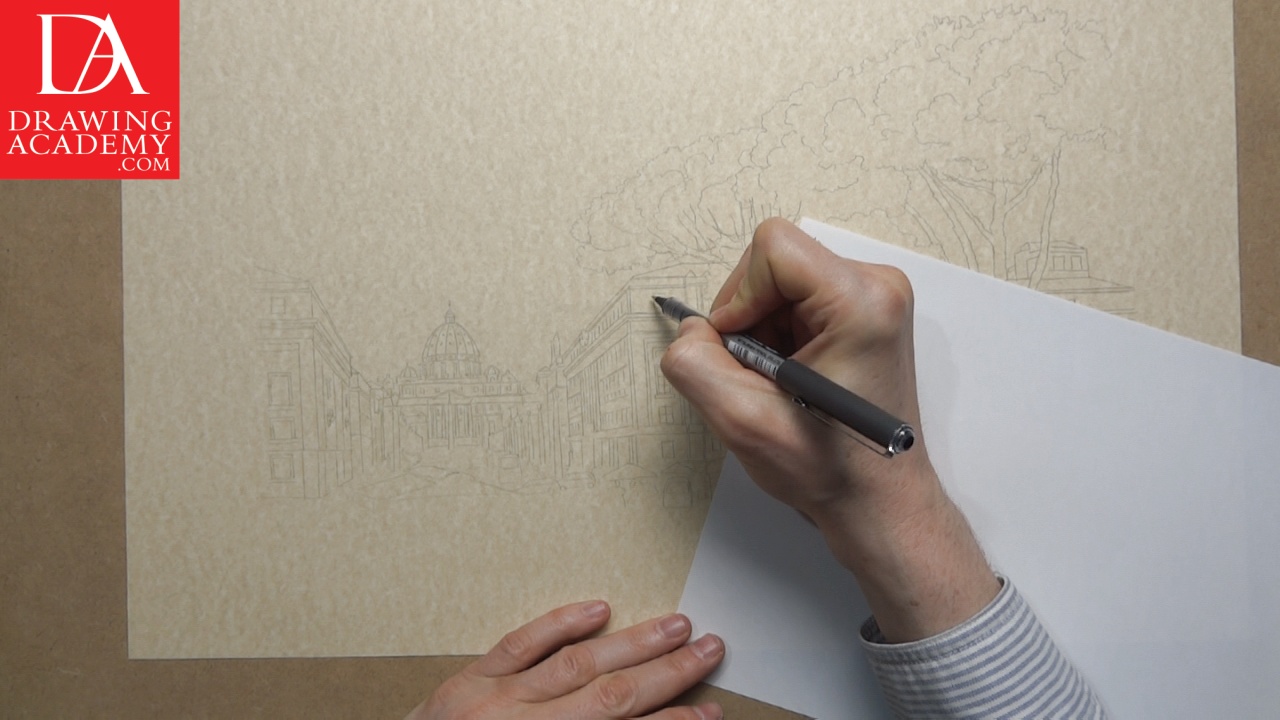Discover How to Draw a House
In this video lesson, you will discover How to Draw a House in black ink.
Enroll in the Drawing Academy Course
Pay once - Enjoy forever!
Only $297
How to Draw a House – Drawing in Ink Techniques
We begin this “How to Draw a House” video part with outlining a house in ink. For that, we will use a Japanese waterproof and fade-proof black ink pen. There are various brands of this type of pen on the market: Pilot, Uni-Ball-Micro, etc. Drawing with a ball-tip ink pen is a bit different to traditional dip pens. This sort of pen goes easily in any direction, and leaves a uniformed thickness of line. Drawing in ink pen can give both an advantage and disadvantage at the same time. It is definitely a less messy business to draw with a ball-tip pen; there’s no nib changing, or ink replacing required. On a downside, though, it is not possible to alter the thickness of lines by varying the pressure on the pen.
When it comes to the topic of “How to Draw a House” in ink, delicate single-line strokes are applied to build-up the tonal values of the artwork. Darker areas are achieved by drawing parallel lines or cross-hatching. At this initial stage of drawing in ink, we are more interested in outlining the contours first, and will come back to work on the tonal values later.

When you consider how to draw a house in ink, an ink pen can be used to draw a series of tiny lines, while keeping some gaps between them; the tonal values are built up into fully rounded images by varying the density of lines. Having bigger gaps between lines will result in lighter values of mid-tones. It is a good practice to keep gaps between lines, even in the darkest shadows. Going totally black is only acceptable in cases when specifically intended by the artist.
Some students ask me ‘Is it acceptable to rotate the paper, maybe turn it on its side, or even turn it upside down while drawing in ink?’ Generally, it isn’t recommended, and you, as a fine artist, should be skilled enough with your hands to make strokes in any direction, without needing to rotate the paper. However, no one is stopping you from doing so; especially if you feel it would give you much better control over the drawing in ink process.
When you think how to draw a house in ink and overcome the limitations of constant line width, you can draw lines with a slight vibration. Even a very straight line can be done as a series of shorter strokes and dots, thus making it look more artistic. This especially applies for objects that are organic in nature, such as trees and bushes; and a natural fluency of lines will add character to the drawing. In contrast to the accurate style of buildings, trees can be depicted with a much looser approach.
Making quick drawings in ink was quite popular among the Old Masters. The versatility of this medium is one of the reasons why they favored it. The Old Masters often highlighted a drawing in ink with a wash, which gives artwork a marvelous look.
It has to be said that drawing in ink requires a great deal of discipline, it is true when it comes to this lesson on “how to draw a house” as well. It might be a bit of a challenge, for a beginner. Also, it would be very difficult – or almost impossible – to correct any mistakes; so a good judgement on tonal values, and making every line as it suppose to be, is quite an important part of the exercise. Drawing in ink is an excellent way to master your drawing skills. The challenges of the medium, present a brilliant opportunity for the artist to train their eye and hand.
While drawing in ink and thinking ‘how to draw a house’, the appearance of a house is first considered as a series of contours, some forming the boundaries of the form against the background, and others the boundaries of the subordinate forms within these bounding lines.
IN this “how to draw a house” video lesson, the light, shade, and differences of local color, are considered together, as tones of varying degrees of lightness and darkness. They are suggested through lines that are drawn parallel, darker, and closer together when depth is wanted; or fainter and further apart, where delicacy is demanded. This rule of parallel shading is broken only when strongly marked forms, such as the crown of trees or leaves of bushes, demand it. This parallel shading gives a beauty of surface to a drawing in ink.
Lines of shading drawn in every direction, crossing each other and resolving themselves into tone effects, suggest atmosphere and the absence of surface form. This is more often used in the background of pen and ink work, and is seldom necessary in pencil or chalk drawing, as they are more concerned with form than atmosphere.
Generally, thinking how to draw a house by rendering shades, lines of shading drawn across a form suggests softness; lines drawn in curves depict a fullness of form; lines drawn down the form show hardness; and lines crossing in all directions, so that only a mystery of tone results, create atmosphere. These four qualities of line give a great deal of expressive power to your shading.
Avoid drawing in ink backwards and forwards when shading, especially when lines are being used to express form. The crossing of lines in shading gives a more opaque look. It is useful in suggesting the opaque appearance of darker areas, for example, in the windows of buildings.




